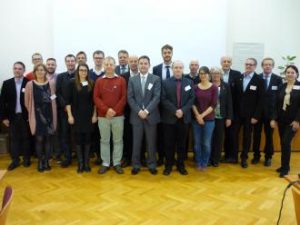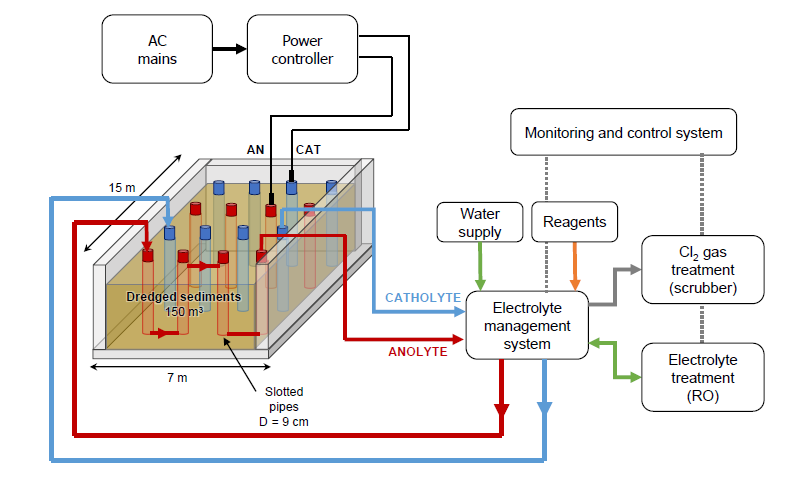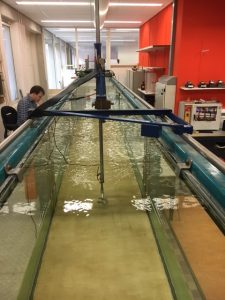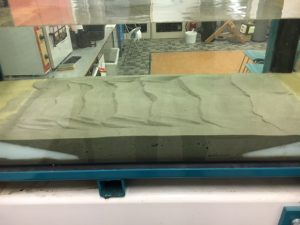Compiled by: Marjan Euser (marjan.euser@deltares.nl)
Subscription Service: SedNet Secretariat (marjan.euser@deltares.nl)
Disclaimer: SedNet is not responsible for faults due to incorrectness of info in this newsletter
Previous issues: www.sednet.org/newsletter
Contents
- Call for Abstracts 10th SedNet Conference 14-17 June 2017
- SEDITERRA and SEDRIPORT
- SedNet-ICPDR-ICPER Round Table Discussion
- Portuguese coastal evolution of low-lying sandy beaches in the last 50 years
- The Sand Motor pilot after five years: building with nature on the Dutch coast
- Sediment ElectroKinetic REmediation Technology for heavy metal pollution removal
- Erodibility of mud
- Upcoming events
Call for Abstracts 10th SedNet Conference 14-17 June 2017
The deadline for submitting abstracts for the 10th International SedNet conference “Sediments on the Move” that will be held in Genoa, Italy, is getting nearer. Please submit your abstract(s) before 16 January 2017 to the SedNet Secretariat.
Conference topics are:
- Sediments moving to land, and soil moving to water
- Sediment balance
- Using sediments as a resource – Sediments in a circular economy
- Policy for sediment management: Finding the balance; “everything is contaminated”
- Climate change; PIANC and SedNet Think Climate! ensure safe and sustainable development?
- Sediment quality
- Sediment quality criteria: derivation, implementation and enforcement
- Effects of remedial measures
- Innovative maintenance of river-delta-sea systems
- Disposal of sediments at sea
- Transboundary sediments
Text of Call and Format for abstract: https://sednet.org/events/sednet-conference-2017/ (section ‘Downloads’)
SEDITERRA and SEDRIPORT
The day prior to the SedNet Conference (on 13 June 2017), there will be free sessions on recently started European projects:
SEDITERRA: Guidelines for the treatment of dredged sediments consistent with a strategy and an assessment of the risks related to a land handling of sediments, provides for the capitalization of the knowledge gained from previous projects that have studied management models and treatment technologies applied to brackish and marine sediments, and the consequent experience gained by the French project partner to promote the reuse of treated dredged sediments in order to create new supply chain in circular economy.
The comparison of the different experiences and the results of the different project phases will be used for the preparation of guidelines applicable within the territorial cross-border, for the management to “land” of dredged sediments not submersible or reusable in marine environments, particularly where the legislation should continue to be lacking.
SEDRIPORT: Sediments, Dredging and Harbor risks
Climate change contributes to facilitate and speed up the structural silting of ports, increasing the risk for both the environment and the economic activities related to maritime transport. It seems clear, especially in case of extreme weather events, such a not quick recovery of a harbor seabed may undermine the economic and social fabric of entire communities. Therefore we need to find practical solutions to the problem through a joint action plan and sharing of guidelines aimed to supporting the actions of governance and to propose a single useful legislation to the whole cross-boundary area.
SEDRIPORT deals with problems common to the area of cooperation, arising from the emergency of the port silting: difficult to program ordinary and extraordinary dredging; incomplete and uncoordinated legislation; inconsistent regulations for the reuse of materials excavated from the port seabed; obligation to the global remediation with unsustainable costs.
Detailed information about the programme of the conference and the sessions on SEDITERRA and SEDRIPORT will become available in spring 2017.
SedNet-ICPDR-ICPER Round Table Discussion: Bringing Together Experiences in Sediment Management Concepts – Elbe meets Danube
Sediment Management is an essential element of River Basin Management Plans. Sediment is an essential, integral and dynamic part of our river basins. Where human activities interfere with sediment quantity or quality, sediment management becomes necessary.
SedNet aims at providing scientific and user oriented input into the WFD implementation phase and organised its third Round Table in cooperation with the International Commission for the Protection of the Danube River and the International Commission for the Protection of the Elbe River.
The Round Table Discussion was organised on 8-9 November at Budapest University. About 20 experts from miscellaneous river basins attended.
The objective of this event was to provide a platform for exchanging experiences between both Danube and Elbe river basins to derive generic and specific recommendations for sediment management based on experiences in selected key river basins taking into account legal requirements, needs of users and scientific advice. The discussion was specifically focused on methodological approaches of designing and implementing a sediment management concept. Representatives from other European river basins where similar activities on sediment management have taken place were invited to take part. Until a few years ago, sediment related quantity and quality issues have played a relatively minor role in the Common Implementation Strategy (CIS) process. Such Round Tables are an opportunity for sediment management experts to exchange experiences on the integration of sediment management in river basin management. Central to the EU WFD are River Basin Management Plans, which were published for the first time in 2009.
A report on the outcome of the Round Table will be published in 2017.
For the reports of previous SedNet Round Table Discussions (2006 and 2009) see www.sednet.org.
Portuguese coastal evolution of low-lying sandy beaches in the last 50 years
Beach erosion is one of the leading problems that coastal regions face worldwide, and coastline evolution studies show how much it affects the coastal system. Usually these studies are site-specific and lack an integrated approach to either a large spatial domain or quantification using a single measurement. The first global Portuguese study on low-lying sandy beaches was developed with an integrated approach and provides an openly accessible database to support knowledge on the coastline evolution of Portuguese low-lying sandy coasts in the last 50 years (https://doi.pangaea.de/10.1594/PANGAEA.859136).
Results show erosion as the dominant trend (−0.24 m year−1), but sandy beach–dune systems display a variable evolution, both in signal and intensity, along and within the eight coastal sediment cells of the studied coast. The study identifies Espinho–Torreira, Costa Nova–Praia de Mira, Cova da Gala–Leirosa, and Cova do Vapor–Costa da Caparica coastal stretches as the most significant beach erosion issues found in the Portuguese coastline. These coastal segments adjacent coastal zone is linked with major human interventions, which interfered with the coastal system, and many of which originated and maintained a sediment deficit. In contrast, the coastal segments Troia–Sines and Sines–Cape S. Vicente have experienced less intervention and show stable or moderate accretion behaviour.
These results brings to light the importance of coastal change evaluation and quantification, but also the importance of understanding the underlying causes of such change, which is intertwined with sediment budgets and sediment practices taking place within the coastal zone and adjacent watersheds.
The study is freely available at http://www.earth-syst-sci-data.net/8/265/2016/ and further information can be obtained by contacting fclira@fc.ul.pt.
The Sand Motor pilot after five years: building with nature on the Dutch coast
The Sand Motor on the Delfland Coast in the Netherlands was created in 2011 as a peninsula covering 128 hectares. It is an innovative pilot project for coastline management intended to contribute to coastal protection in the long term. The intention was also to create an additional appealing area for nature and leisure activities on the Delfland coast and to boost current knowledge about coastline management. A monitoring programme has been conducted for the purposes of knowledge development and in order to evaluate whether the objectives have been met.
In the first year after construction, the Sand Motor changed shape faster than expected but in line with the expected pattern based on model calculations in the design phase. Changes after that were slower than expected. The sand body extends about 260 meters less into the sea than when it was created in 2011. At the same time, the area where the coast has been extended seawards became 2.2 kilometres longer. After four years, 95% of the sand used for the Sand Motor is still in the monitoring area and 80% of that sand is still within the contours of the sand body created in 2011. On this basis, it is legitimate to conclude that the lifetime of the Sand Motor will exceed twenty years.
The Sand Motor is a unique feature on the coast of Holland between the cities Hook of Holland and Den Helder. There is more fine and nutrient-rich sediment in these locations, making richer benthic life possible. And that has a positive impact on other species such as birds and fish.
It will become clear during the coming monitoring period whether or not species that live longer will be able to develop in areas where small layers of sand are deposited regularly due to natural dynamics but that are not covered by thick layers.
During and immediately after construction, attitudes were slightly critical. An increasingly large group now approves of the Sand Motor and the project enjoys widespread support.
No safety problems for leisure visitors arose that could not be managed.
The programme is generating new knowledge that can be used for coastline management, for example with respect to the impact of a major nourishment operation on morphology, leisure activities and the ecology. Some of the knowledge development is already being actively used, an example being the app developed for bather safety
The monitoring of the Sand Motor will continue through to 2021. Rijkswaterstaat is leading the effort. In 2021, there will be a solid scientific evaluation of the Sand Motor concept because we will then have a firmer understanding of how the Sand Motor works.
For more info: http://www.dezandmotor.nl/en/
Sediment ElectroKinetic REmediation Technology for heavy metal pollution removal: the LIFE SEKRET project (LIFE12 ENV/IT/000442)
In 2003, a large area of the port of Livorno has been classified as a Site of National Interest (SIN) due to the presence of pollutants in seabed sediments. A Site of National Interest (SIN) represents a very large contaminated area, classified by the Italian legislation as a dangerous area which needs remediation to prevent damage to the environment and health. The site has been subjected to a series of in-depth analyses and characterisations over time. The seabed sediments were analysed by ICRAM (Central Institute for Scientific and Technological Research Applied to the Sea) and the characterisation was carried out over an area of 14 million m2 within the port seabed. The characterisation surveys have shown that many areas of the harbour were affected by extremely high contamination level.
The SEKRET project is configured in this context as a future reference point for the improvement of sediment management policies and the increase of sustainability of sediment dredging activities. The project aims to demonstrate the efficacy and reproducibility of the electrokinetic method for the treatment of contaminated sediments in order to make them reusable in the environment, transforming them as an useful resource. The project involves the participation of six beneficiaries: University of Pisa, University of Rome ’La Sapienza’, West Systems s.r.l., Port Authority of Livorno, Tuscany Region and Lambda Consult.
The project started in January 2013 and will end in November 2017. The main project’s actions involved the implementation of an ex-situ electrokinetic treatment facility, which was built in a dedicated area in the Port of Livorno (Italy) and started operation on July 2015. The sediment treatment, which is currently ongoing, will be completed by the end of the project. The pollutants targeted by the remediation process are Cd, Cr, Pb, Ni, Zn, As and Cu. The project goal is to decontaminate the sediments in order to make them compliant with the levels established by the Italian regulations (Legislative Decree 152/2006) for their reuse or recycle.
The plant consists of the following parts:
- treatment basin containing the sediments, with a system of wells and pipes for electrode installation and electrolyte circulation. The basin is equipped with a cover to avoid gas emission to atmosphere and rainfall seepage;
- electrical units for the application of the electric field to the sediment;
- electrolyte management system for catholyte and anolyte pH control;
- gas scrubber system for the treatment of the gas phase in the anolyte circulation circuit for the removal of chlorine gas;
- reverse osmosis (RO) section for the control of the salinity of the electrolytes with solar drying of brine;
- monitoring and control system.
The simplified diagram of the plant is reported in Figure 1.
Figure 1
For further and detailed information please contact the project team at the following page http://lifesekret.com/contact-us/ or visit the project website (http://lifesekret.com/).
Erodibility of mud
Two students from Hanze University in Groningen, the Netherlands, are investigating the erodibility of estuarine mud for SEMASO BV.
Dredging the ports and entrance channels in the Waddensea estuary is an ongoing business to keep them accessible for vessels. This dredging is very expensive and sometimes the effect is unfortunately very temporarily: already after one storm the channel could be silted up again. A structural, cost saving and sustainable solution should be found for the siltation problem of ports and entrance channels in estuaries. A so called ‘flush lake’ could be an ideal solution.
A ‘flush lake’ is a lake which is filled up and emptied due to the tidal difference. With high tide the ‘flush lake’ is filled and with low tide the ‘flush lake’ is emptied. The emptying of the ‘flush lake’ creates a flush through the port or channel and the erosion of the mud will be transported out of the area. This natural solution does not require much maintenance, it can be fully automated and less dredging is required.
The students will use the water flume of the Hanze University to determine the erodibility of mud under varying water currents.
Several tests have been performed with sands of different main grain sizes (D50) in the last couple of weeks. The sands have been monitored with different water flows and preliminary results show good comparison with the ‘Shields curve’. Next step would be to test sediments from a port in the Waddensea estuary.
For more information please contact BSc. René Barth (r.barth@semaso.com).
Upcoming events
9-12 January 2017: Battelle – Ninth International Conference on Remediation of Contaminated Sediments, New Orleans, Louisiana. More information at the conference website: http://www.battelle.org/newsroom/conferences/sedimentscon
8-9 February 2017: North American Dredging Summit, Houston, Texas, USA. http://www.wplgroup.com/aci/event/dredging-summit-america/
26-28 February 2017: International Conference on Sedimentology and Petroleum Geology (SPG 2017), Sanya, China. www.engii.org/conf/SPG/2017Feb/
27-28 March 2017: Navigating a Changing Climate, Brussels, Belgium. An international conference exploring the implications of climate change for waterborne transport infrastructure. http://navclimate.pianc.org/events
7-11 May 2017: SETAC Europe 27th Annual Meeting, Brussels, Belgium. Event of the Society of Environmental Toxicology and Chemistry. https://www.setac.org/events/EventDetails.aspx?id=683532
21-26 May 2017: 14th International Symposium on the Interactions between Sediments and Water, Taormina, Italy, organized by the International Association for Sediment Water Science (IASWS). http://www.iasws2017.altervista.org/
14-17 June 2017: 10th International SedNet Conference, co-organised and hosted by University of Genoa/DISTAV and the Port of Genoa Authority. Deadline for abstract submission is 16 January 2016. www.sednet.org
26-30 June 2017: AquaConSoil 2017, Lyon, France. 14th International Conference on Sustainable Use and Management of Soil, Sediment and Water Resources. www.aquaconsoil.org
Disseminated by:
SedNet secretariat:
Mrs. Marjan Euser
Deltares
P.O. Box 85467
NL-3508 AL Utrecht, The Netherlands
Email marjan.euser@deltares.nl






